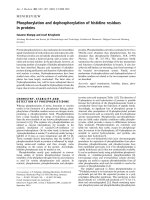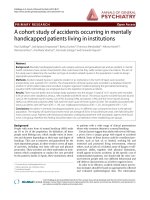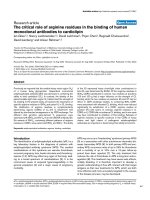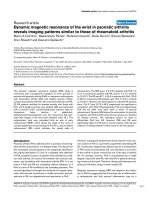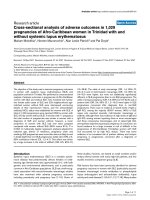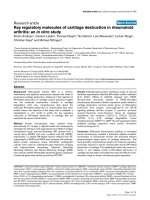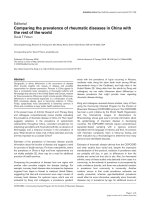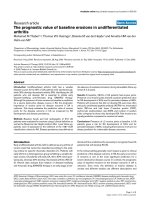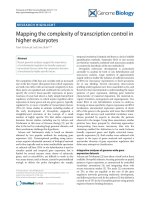Báo cáo Y học: Phosphorylation and dephosphorylation of histidine residues in proteins Susanne Klumpp and Josef Krieglstein Abteilung Biochemie und Institut fu¨r Pharmakologie und ppt
Bạn đang xem bản rút gọn của tài liệu. Xem và tải ngay bản đầy đủ của tài liệu tại đây (111.55 KB, 5 trang )
MINIREVIEW
Phosphorylation and dephosphorylation of histidine residues
in proteins
Susanne Klumpp and Josef Krieglstein
Abteilung Biochemie und Institut fu
¨
r Pharmakologie und Toxikologie, Fachbereich Pharmazie, Philipps-Universita
¨
t Marburg,
Germany
Protein phosphorylation is a key mechanism for intracellular
signal transduction in both prokaryotic and eukaryotic cells.
Vertebrate proteins are prevalently phosphorylated on side
chains that contain a hydroxyl group, such as serine, thre-
onine and tyrosine residues. In the past decade, however, an
increasing number of examples of histidine phosphorylation
has been described. Because acid treatment of phospho-
proteins during purification and detection o f phosphoamino
acid analysis is routine, O-phosphomonoesters have been
studied more often, and the existence of acid-labile phos-
phates h as been largely o verlooked. The latter class of
N-phosphoamidates may well be more widespread than is
generally believed, even though the O-phosphates r emain th e
major class in terms of quantity and extent of distribution in
proteins. Phosphohistidine currently is estimated to be 10- to
100-fold more a bundant than phosphotyrosine, but less
abundant than phosphoserine [Matthews, H.R. (1995)
Pharmac. Ther. 67, 323–350.]. This minireview briefly
summarizes the extensive knowledge of the key mechanisms
and functions of phosphohistidine in bacteria. It also des-
cribes the still limited, yet increasing, data from homologs of
the bacterial two-component system. Finally, novel
mechanisms of phosphorylation a nd dephosphorylation of
histidine residues not related to the two-component system
are d escribed.
Keywords: signal transduction; histidine; kinase; phos-
phatase; t wo-component system.
CHEMISTRY, STABILITY AND
DETECTION OF PHOSPHOHISTIDINE
Whereas phosphorylation of serine, threonine or tyrosine
results in the formation of a phosphoester linkage, phos-
phorylation of histidine residues o ccurs on nitro gen atoms,
producing a phosphoramidate bond. Phosphohistidines
have a large standard free energy of hydrolysis making
them the most unstable of any known phosphoamino acid
(reviewed in [1]). This explains why phosphohistidines are
utilized as enzyme intermediates, for example, in the
catalytic mechanism of succinyl-CoA-synthetase or
glucose-6-phosphatase. On the other hand, in histone H4,
1-phosphohistidine at residue 75 is relatively stable, having a
half-life of 12 days at room temperature and pH 7.6 [2].
Those examples clearly demonstrate that the stability of
phosphoramidate bonds in proteins is influenced by neigh-
boring amino-acid residues and thus strongly varies
depending on the nature o f t he protein. Accordingly,
histidine phosphatases may be needed or not.
Phosphohistidine mostly goes undetected in conven-
tional s tudies of protein phosphorylation because of
instability o f t he phosphate-nitrogen bond in acid solutions
as used for routine phosphoamino acid analysis. I n
contrast, phosphoserine, phosphothreonine and phospho-
tyrosine resist acid treatment (Table 1) [ 3]. The detection of
O-phosphates in acid hydrolysates of proteins is possible
because the hydrolysis of the phosphomonoester bonds is
considerably slower than the hydrolysis of p eptide bonds.
Accordingly, no significant loss of phosphoryl groups is
observed after precipitation of O-phosphorylated proteins
by trichloroacetic acid as commonly used f or phosphatase
activity measurements. Phosphoserine and phosphothreo-
nine are labile under alkaline conditions unlike phospho-
tyrosine, which provides a means to differentiate between
these molecules. Phosphoramidates are extremely acid
labile but relatively base stable, except for phosphoargi-
nine. In contrast to the O -phosphates, all N -phosphates are
unstable to neutral hydroxylamine, and pyridine also
catalyzes their hydrolysis [3].
One- and two-dimensional thin layer chromatography
procedures for separation of phosphohistidine from phos-
phoserine, phosphothreonine and phosphotyrosine have
been established previously [1,3]. Free phosphohistidine is
rapidly hydrolyzed, a nd is thus not commercially available.
It can be synthesized easily using polyhistidine/phosp horyl-
chloride or
L
-histidine/potassium phosphoramidate [4].
Ion-exchange resins and reversed-phase column chroma-
tography are useful to separate phosphohistidine from all
other phosphoamino acids and also suitable to resolve t he
isomers of phosphohistidine [1,4].
The simplest approach to detect phosphohistidine in
32
P-labeled prote ins is to fractionate the proteins o n a poly-
acrylamide gel and blot the separated proteins to a poly
(vinylidene difluoride) membrane. This membrane is then
placed directly in 1
M
KOH and incubated at 5 5 °Cfor2h,
dried and autoradiographed [3,5]. Bands remaining repre-
sent phosphotyrosine a nd ph osp hohistidine/phospholysine.
Correspondence to S. Klumpp, Abteilung Biochemie, Fachbereich
Pharmazie, Marbacher Weg 6, D-35032 Marburg, Germany.
Fax: + 49 6421 282 6645, Tel.: + 49 6421 282 6646,
E-mail:
(Received 6 August 200 1, revised 2 1 September 2001, accepted 26
September 2001)
Eur. J. Biochem. 269, 1067–1071 (2002) Ó FEBS 2002
Additional treatment of the membrane with 6
M
HCl at
55 °C for 2 h leaves only phosphotyrosine. Diethyl pyro-
carbonate is the most frequently used histidine modifying
reagent p reventing s ubsequent phosphorylation of histidine
residues.
Screening for proteins containing N -linked phosphate
with antibodies to phosphohistidine is not yet possible.
Attempts t o prepare antibodies to derivatives o r conjugates
of phosphohistidine have not been successful. However,
many of the commercially available anti-phosphotyrosine Ig
also recognize phosphohistidine.
PHOSPHOHISTIDINE IN BACTERIA:
THE TWO-COMPONENT SYSTEMS
In prokaryo tic signaling, the p redominant phosphorylation
scheme is referred to as Ôtwo-componentÕ system [6,7].
It frequently is involved in linking an extracellular stimulus
such a s changing osmolarity, oxyg en, n itrogen or phospho-
rus levels to gene regulating events, but also affects
differentiation and other functions, such as chemotaxis.
Two-component systems are abundant in most eubacte-
ria, in which they typically constitute at least 1% of encoded
proteins. The Escherichia c oli genome encodes 62 two-
component proteins. Two-component systems are present
in both Gram p ositive and Gram negative b acteria.
In addition to housekeeping functions, they also control
expression of toxins and o ther proteins i mportant for
pathogenesis.
The two-component signal transduction pathway consists
of a sensor that is connected to a regulator through histidine
phosphorylation and a subsequent phosphotransfer event
to aspartate. The response t ime is q uite fast. The two-
component system comprises several c haracteristic domains
usually structured on two conserved proteins: a histidine
kinase/sensor and a response regulator that are phosphor-
ylated at histidine and aspartate residues, respectively
(Fig. 1). Stimuli, detected by a sensor domain of the
histidine kinase, regulate histid ine k inase a ctivities. The
histidine kinase c atalyzes an ATP-dependent trans-auto-
phosphorylation reaction i n which one subunit o f the dimer
phosphorylates a specific histidine residue within the other
Table 1. Chemical stability of phosphorylated amino acids. +, stable
phosphoamino acid; –, labile phosphoamino acid.
Stability in
Nature of phosphoamino acid Acid Alkali
O-Phosphates
Phosphoserine + –
Phosphothreonine + ±
Phophotyrosine + +
N-Phosphates
Phosphoarginine – –
Phosphohistidine – +
Phospholysine – +
Acyl-Phosphate
Phosphoaspartate – –
Fig. 1. The two-component phosphotransfer scheme. This typically consists of a dimeric transmembrane sensor histidine kinase (component I) and a
cytoplasmic response regulator (component II). However, there are variations, e.g. the cytosolic histidine kinases C heA, and multicomponent
phosphorelay systems, which consist of even three proteins: a hybrid histidine kinase with an additional resp onse regulator domain at the
C-terminus; a separate histidine-containing phosphotransfer protein that serves as a histidine phosphate intermediate; and the response regulator.
The two-component h istidine kinase do main is a m odule o f % 250 amino acids that has four c onserved bloc ks of amino-acid sequences l ocated
within the ATP -binding domain (N, G
1
, F an d G2). Similarly, the response regulator domain can be identified from th e number and spacing of
conserved aspartate, l ysine, and hydrophobic r esid ues in a module of %120 amino acids. A bbreviation: TM, t ransmembrane.
1068 S. Klumpp and J. Krieglstein (Eur. J. Biochem. 269) Ó FEBS 2002
subunit resulting in a phosphoimidazole. The response
regulator then catalyzes transfer of the phosphoryl group
from the phosphohistidine to one of its o wn aspartate
residues. Phosphorylation of the conserved regulatory
domain of the response regulator activates an effector
domain that elicits the specific output response, for example,
change in flagella motion or change in transcription.
Structures of the bacterial histidine protein kinase cata-
lytic domains are unlike those of any p reviously character-
ized serine-, threonine- or tyrosine kinase [8,9]. However, the
histidine kinase structures are related to ATPase domains of
the t ype I I t opoisomerase gyrase B and the chaperone
Hsp90. A highly conserved glutamic acid residue is predic-
ted to be involved in the catalytic mechanism of the ATPase
enzymes. This glutamic acid is not present in the histidine
kinase active site, which might e xplain why members of this
superfamily function as kinases and others as ATPases.
TWO-COMPONENT SYSTEMS IN YEAST,
AMOEBA, FUNGI AND PLANT
Although two-component pathways are common in
bacteria, evidence for their e xistence in eukaryotes is scarce.
Starting no more than a decade ago, the field of reversible
histidine phosphorylation i n e ukaryotes finally is beginning
to emerge. By aligning members of the bacterial two-
component histidine kinase f amily, oligonucleotide p rimers
were designed to amplify t he kinase domain. This approach
proved successful to clone homologs to the bacterial
histidine kinases and response regulators in yeast, amoeba,
fungi and plants.
The best documented linkage between prokaryotic and
eukaryotic two-component signal transduction mechanisms
is for the osmoregulation system in yeast. The SLN1 and
SSK1 proteins of Saccharomyces cerevisiae have sequence
similarities to both the histidine kinase and the response
regulator p roteins from bacteria, respectively [10,11]. Gen-
etic analysis of site-directed mutants indicates that SLN1/
SSK1 act in the same manner as do its bacterial counter-
parts, i.e. through f ormation of a phosphohistidyl enzyme
followed by phosphotransfer to an aspartyl residue on its
response regulator. Interestingly, this histidine protein
kinase from yeast is part of a signaling cascade in which
traditional eukaryotic mitogen-activated protein k inases
participate as downstream elements (HOG1 MAPK
cascade).
The gene dokA from the slime mold Dictyostelium
discoideum codes for a homolog of the bacterial hybrid
histidine kinase family which is defined by the presence of
conserved a mino-acid sequence motifs corresponding to an
N-terminal receptor domain, a central histidine kinase and a
C-terminal response regulator [12]. DokA mutants are
deficient in the osmoregulatory pathway, resulting in
premature cell death of this amoeba under high osmotic
stress. The predicted protein sequence of the gene nik-1 from
the fungus Neurospora crassa also shares homology with
both the kinase and response regulator modules of two-com-
ponent signaling proteins [13]. Deletion studies revealed that
Nik-1 is involved in p roper h yphal development. In p lants,
the simple gas ethylene (C
2
H
4
) serves as a hormone with
profound effects on g rowth and development. The
C-terminal half of the ethylene response protein ETR1 in
the p lant Arab idopsis thalia na is similar i n sequence to both
components o f t he prokaryotic family of signal transducers
known as the two-component system [14,15]. Similar to
SLN1, ETR1 also i s involved in a MAPK cascade.
One has to bear in mind, however, t hat the statement of
dealing with analogs of the prokaryotic two-component
systems so far is based on homology cloning resulting in
amino-acid similarity and based on functional studies
employing deletion/mutations. Histidine phosphorylation
of the isolated or recombinant proteins, as extensively
performed for the bacterial histidine kinase CheA, has not
been studied. So far, only one protein histidine kinase has
been purified from eukaryotes on the basis of activity
measurements. The enzyme was isolated from S. cerevisiae
[16].
HISTIDINE PHOSPHORYLATION
AND DEPHOSPHORYLATION
IN MAMMALIAN SYSTEMS
Until now, two-component proteins have not been identi-
fied in a nimals and a re not encoded by worm, fly or human
genomes. It therefore has been suggested that the building
blocks of the two-component systems in lower organisms
may provide a target for the development of antibiotics
directed against both fungal a nd bacterial pathogens i n
vertebrates.
Two eukaryotic genes have been discovered whose
predicted products exhibit limited structural homology to
the bacterial histidine protein kinases, however, functional
homology c ould not be dem onstrated. The gene which
encodes branched-chain a-ketoacid dehydrogenase kinase
(BCKDH kinase) w as cloned in 1992 [17]. The sequence of
this enzyme shows no resemblance to any e ukaryotic
protein kinase. The closest homologs to BCKDH kinase
are found among the histidine protein kinases of bacteria.
Direct evidence for histidine phosphorylation of BCKDH
kinase still is lacking. In contrast, BCKDH kinase auto-
phosphorylates on serine and phosphorylates its physiolo-
gical substrate, branched-chain a-ketoacid dehydrogenase,
on a p air of serine residues a s well. Pyruvate dehydrogenase
kinase from rats is an other e xample o f a protein with weak
resemblance to histidine p rotein kinases from bacteria. As
described for BCKDH kinase, pyruvate dehydrogenase
kinase phosphorylates proteins on hydroxyl amino acids.
Although there is no evidence for the existence of two-
component systems in vertebrates yet, there are numerous
reports on histidine phosphorylation i n v ertebrate p roteins.
The description o f phosphohistidine in mammals started in
the 1970s when Smith’s group [18] studied a rat nuclear
protein kinase that phosphorylates histone H4 on histidine.
In the 1990s, Motojima & Goto [19] and Hedge & Das [20]
were studying the proteins p36 and p38, respectively. The
proteins may be identical: both proteins are p hosphorylated
in response to the presence of Ras protein and guanine
nucleotides, and the phosphorylation occurs on a histidine
residue. Noiman & Shaul [21] developed a protocol for
rapid detection of histidine phosphoproteins in cellular
crude extracts. Running the phosphorylation reactions in
the presence of 5 m
M
EDTA (instead of Mg
2+
) exclusively
results in histidine phosphorylation.
In 1995 , a nov el pathway for activation-dependent signal
transduction in vertebrates was introduced [22]. A ligand-
induced cascade g enerates phosphohistidine in platelets.
Ó FEBS 2002 Histidine phosphorylation (Eur. J. Biochem. 269) 1069
In addition to well known phosphorylation on serine,
threonine and tyrosine residues, thrombin and collagen lead
to the phosphorylation of histidine in the cytoplasmic tail of
P-selectin. The appearance and disappearance of phos-
phohistidine on P-selectin are very rapid.
The next finding of an intracellular signaling system
involving histidine phosphorylation in mammals appeared
in 2000 [23]. A 37-kDa protein from airway epithelia is
phosphorylated on histidine and was identified as annexin I.
It is a member of a family of Ca
2+
-dependent phospholipid-
binding proteins whose phosphorylation is regulated by the
chloride-ion concentration. The failure of annexin I to
autophosphorylate i ndicates t hat i t is a substrate for a
distinct yet undiscovered histidine kinase.
Histidine i s an i mportant catalytic residue in many
enzymes. In some cases, the histidine is covalently modified
during the reaction. In a further subset, the modified form is
phosphohistidine. Such phosphohistidine intermediates are
not discussed in this article.
DEPHOSPHORYLATION
OF PHOSPHOHISTIDINE
In prokaryotes
Many bacterial two-component histidine k inases are
bifunctional, having both kinase activity (acting on histi-
dine) and phosphatase activity (acting on phosphoaspar-
tate). Response regulators are the targets for the histidine
kinase phosphatases. In the case of EnvZ, the osmosensor in
E. coli and its cognate r esponse regulator OmpR [24], it has
been suggested that OmpR-P is regulated by the OmpR-P
phosphatase activity, whereas the OmpR kinase activity is
maintained at a c onstant le vel. Similarly, in the CheA
chemotaxis system, dephosphorylation of the phospho-
CheY response regulator is modulated by the CheZ
phosphatase.
The SixA protein from E. coli is a prokaryotic phos-
phohistidine phosphatase discovered recently [25]. SixA
plays a role in d own-regulation of the Arc B-to-ArcA
phosphorelay under certain anaerobic respiratory condi-
tions. This histidine phosphatase activity is directed towards
the phosphotransmitter domain of the bacterial hybrid
histidine kinase. SixA consists of 161 amino acids and has
an arginine-histidine-glycine signature at the N-terminus,
which presumably functions as a nucleophilic phosp hoac-
ceptor.
In mammals
Because a mammalian histidine kinase is not available yet,
all published studies of protein histidine phosphatases in
vertebrates so far have been carried out with histone H4
phosphorylated by the histidine kinase purified from yeast.
Among the classical eukaryo tic protein phosphatases,
protein tyrosine p hosphatases and the serine/threonine
phosphatase type 2B (calcineurin) do not dephosphorylate
H4 phosphorylated on histidine. The serine/threonine
protein phosphatases type 1, t ype 2 A a nd type 2C, in
contrast, a re highly active against phosphohistidine in
histone H4 (reviewed in [1]). Intriguingly, none of the
serine/threonine phosphatases acting on histidine phosphor-
ylated histone, hydrolyze phosphohistidine using the
bacterial histidine kinase CheA autophosphorylated on
histidine 48 as a substrate [26].
In 2000, SixA was the first bacterial histidine phosphatase
identified implicated in the histidine to aspartate phospho-
relay (see above [25]). In the meantime, the first mammalian
protein histidine phosphatase has also b een discovered [26].
Both enzymes are o f low apparent molecular m ass (17 and
14 k Da, respectively), hence similar in size to eukaryotic low
molecular mass protein tyrosine phosphatases. But the
proteins are c learly distinct. Vertebrate p rotein histidine
phosphatase (PHP1) was isolated from rabbit liver. Its
amino-acid sequence shows no resemblance to any phos-
phatase described so far. Furthermore, inhibitors of phos-
phatases acting on phosphoserine, phosphothreonine and
phosphotyrosine residues h ad no effect. Protein histidine
phosphatase is present in a variety of species from human to
nematodes, but absent in bacteria. It is highly expressed
throughout different tissues. ATP-citrate lyase known to
undergo autophosphorylation on histidine [27] as well as
external phosphorylation on histidine via nucleoside
diphosphate kinase [28], is t he first vertebrate substrate
identified for protein histidine phosphatase [26].
SUMMARY
Knowledge of the phosphorylation and dephosphorylation
of histidine residues in bacterial proteins is vast. In
contrast, very little is known about the reversible phos-
phorylation of histidine in vertebrates. We have recently
learned that the dogma of histidine phosphorylation/
dephosphorylation in bacteria on the one hand vs. serine/
threonine and tyrosine phosphorylation/dephosphorylation
in vertebrates on the other, is no longer realistic [29].
It may be time to look for the more transiently phosphor-
ylated amino acids, histidine and aspartic acid, as protein
modifications resulting in mammalian signal t ransduction.
The few reports on that topic published within the last
decade look promising.
REFERENCES
1. Matthews, H.R. (1995) Protein kinases and phosphatases that act
on histidine, lysine, or arginine residues in eukaryotic p roteins: a
possible regulator of the mitogen-activated protein kinase cascade.
Pharmac. T her. 67, 3 23–350.
2. Kim, Y., Pesis, K.H. & Matthews, H.R. (1995) Removal of
phosphate from phosphohistidine in proteins. Biochim. Biophys.
Acta 1268, 221 –228.
3. Duclos, B., Marcandier, S. & Cozzone, A.J. (1991) Chemical
properties and separation of phosphoamino acids by thin-layer
chromatography and/or electrophoresis. Methods Enzymol. 201,
10–21.
4. Wie, Y F. & Matthews, H.R. (1991) Identification of phospho-
histidine i n proteins a nd puri fication of protein-histidine kinases.
Methods E nzymol. 200, 388 –414.
5. Kamps, M.P. (199 1) Determination o f phosphoamino acid com-
position by acid hydrolysis o f protein blott ed to immobilo n.
Methods E nzymol. 201, 21– 27.
6. Alex, L. & Simon, M.I. (1994) Protein histidine kinases and signal
transduction in prokaryotes and eukaryo tes. Trends Genet. 10,
133–138.
7. West, A .H. & Stock, A.M. (2001) Histidine k inases and response
regulator proteins in two-component signaling systems. Trends
Biochem. Sc i. 26, 369–376.
1070 S. Klumpp and J. Krieglstein (Eur. J. Biochem. 269) Ó FEBS 2002
8. Bilwes, A.M., Alex, L.A., Crane, B.R. & Simon, M.I. (1999)
Structure of CheA, a signal-transducing h istidine ki nase. Cell 96 ,
131–141.
9. Tanaka, T., Saha, S.K., Tomomori, C., Ishima, R., Liu, D., Tong,
K.I., Park, H., Dutta, R., Qin, L., Swindells, M.B., Yamazaki, T.,
Ono, A.M., Kainosho, M., Inouye, M. & Ikura, M. (1998) NMR
structure of the histidine kinase domain of the E. coli osmosensor
EnvZ. Na tu re 396, 8 8–92.
10.Ota,I.M.&Varshavsky,A.(1993)Ayeastproteinsimilarto
bacterial two-component regulators. Science 262, 566–569.
11. Maeda, T., Wurgler-Murphy, S.M. & Saito, H. (1994) A two-
component system that regulates an osmosensing MAP kinase
cascade i n yeast. Nature 369, 242–245.
12. Schuster, S .S., Noegel, A.A., Oehme, F., Gerisch, G . & Simon,
M.I. (1996) The hybrid histidine k inase DokA is part of the
osmotic response system of Dictyostelium. EMBO J. 15,
3880–3889.
13. Alex, L.A., Borkovich, K.A. & Simon, M .I. (1996) Hyphal
development in Neurospora crassa: involvement o f a t wo-comp o-
nent his tidine kinase. Proc. Natl Acad. Sci. USA 93 , 3416–3421.
14. Chang, C., Kwok, S.F., Bleecker, A.B. & Meyerowitz, E.M.
(1993) Arabidopsis ethylene-response gene ETR1: similarity of
product to two-component regulators. Science 262 , 539–544.
15. Chang, C. & Meyerowitz, E.M. (1995) The ethylene hormone
response in Arabidopsis: a eukaryotic two-comp onent signaling
system. Proc. Natl Acad. Sci. USA 92, 4 129–4133.
16. Huang, J., Wei, Y., Kim, Y., Osterberg, L. & Matthews, H.R.
(1991) Purification of a protein histidine kinase from the yeast
Saccharomyces cerevisiae. J. Biol. Chem. 266, 902 3–9031.
17. Popov, K.M., Zhao, Y., Shimomura, Y ., Kuntz, M.J. & Harris,
R.A. (1992) Branched-chain a-ketoacid dehydrogenase kinase.
J. Biol. Chem. 267, 1 3127–13130.
18. Chen, C.C., Bruegger, B.B., Kern, C.W., Lin, Y.C., Halpern,
R.M. & Smith, R.A. (1977) Phosphorylation of nuclear proteins in
rat regenerating liver. Biochemistry 16 , 4852–4855.
19. Motojima, K. & Goto, S. (1993) A protein histidine kinase
induced in rat liver b y peroxisome p roliferators. FEBS Lett . 319,
75–79.
20. Hegde, A.N. & Das, M.R. (1987) Ras proteins enhance the
phosphorylation of a 38 kDa protein (p38) in rat liver plasma
membrane. FE BS Lett. 217, 74–80.
21. Noiman, S . & Shaul, Y. ( 1995) Detection of histidine-phosp ho-
proteins in animal tissues. FEBS Lett. 364, 63–66.
22. Crovello, C.S., Furie, B.C. & Furie, B. (1995) Histidine phos-
phorylationofP-selectinuponstimulationofhumanplatelets:a
novel p ath way for activatio n-dependen t signal transduction. Cell
82, 279 –286.
23. Muimo, R., Hornickova, Z ., Riemen, C.E. , Gerke, V.,
Matthews, H. & Mehta, A. (2000) Histidine phosphorylation of
annexin I in airway epithelia. J. Biol. C hem. 275, 36632–36636.
24. Zhu, Y., Qin, L ., Y oshida, T. & Inouye, M. (2000) Phosphatase
activity of histidine kinase EnvZ without kinase catalytic domain .
Proc. Natl Acad. Sci. USA 97, 7808–7813.
25. Matsubara, M. & Mizuno, T. (2 000) The SixA phospho-histidine
phosphatase modulates the ArcB phosphorelay signal transdu c-
tion in Escherichia coli. FEBS L ett. 470, 1 18–124.
26. Klumpp, S., Hermesmeier, J., Selke, D., Bechmann, G., Kriegl-
stein, J., Van den Brulle, J., Weidner, G., Scharm, B., Gu
¨
ssow, D.,
Baumeister,R.&Kellner,R.(2002)Vertebrateproteinhistidine
phosphatase: identification a nd functional studies. EMB O
Reports, in press.
27. Cottam, G.L. & Srere, P.A. (1969) Nature of the phosphorylated
residue in citrate cleavage enzyme. Biochem. Biophys. Res.
Commun. 35, 8 95–900.
28. Wagner, P.D. & Vu, N D. (1995) Phosphorylation of ATP-citrate
lyase by nucleoside diphosphate k inase. J. Biol. C hem . 270, 21758–
21764.
29. Kennelly, P.J. & Potts, M. (1996) Fancy meeting you here! A fresh
look at ÔprokaryoticÕ protein pho sphorylation. J. Bacteriol. 178,
4759–4764.
Ó FEBS 2002 Histidine phosphorylation (Eur. J. Biochem. 269) 1071

